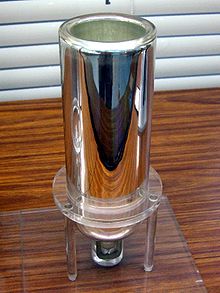Dewar flask
A dewar vessel is a mirrored, double-walled, evacuated vessel made of glass or stainless steel . It is used in thermos / vacuum jugs as well as in special laboratory containers.
The dewar flask is used for good thermal insulation of the material stored in it from the environment. Cold or hot substances, mostly liquids , are stored in it. In everyday life you can often find it in commercially available vacuum jugs, in which, for example, coffee is kept hot.
It is named after the Scottish physicist Sir James Dewar , who used vacuum vessels for the first time in 1874 and in 1893 introduced mirrored glass vessels as transport vessels for liquefied gases.
In his textbook “Physical Demonstrations”, Adolf Ferdinand Weinhold also described a vacuum jacket bottle for laboratory purposes in 1881.
development
Conventional Dewar vessels made of double-walled glass, silver-plated inside, which is evacuated and - mostly at the bottom with a break-off-sensitive - melting glass nipple, were originally in turned wooden cups with a felt bedding and wooden lid, later on a cork ring in a cylindrical tin can, almost exclusively in use in the laboratory . Their own is the risk of breakage, both by hitting the outer glass wall z. B. by a mixing spoon, as well as by the inertia of the filling on the inner part, especially with side impact.
After being used in laboratory technology, Dewar flasks made of double-walled stainless steel sheet were also sold in mountain sports around 1980. They are joined by arc welding in a vacuum at the pouring edge, no longer require an extra housing, may dent a little, but are highly break-proof. The mass production in the Far East lowered the price, so that they prevailed against glass dewars in the sports sector as early as 1990. The relatively low heat conduction for metals (relevant only in the neck and closure area) of NiRo steel has a favorable effect.
functionality
A dewar flask reduces the three possible heat transfer processes heat conduction , heat radiation and convection . The heat conduction is influenced both by the choice of material (glass has a very low thermal conductivity ) and by the shape of the vessel. Since the inner part of the vessel is only connected to the outer part via the upper edge, the heat has to be transmitted over a relatively long distance, which limits heat conduction. The heat transfer through radiation is reduced by mirroring the container walls. The evacuation prevents the transport of heat by convection. The heat transport through particle collisions is only reduced when the mean free path of the remaining gas particles in the vacuum is longer than the distance between the delimiting surfaces. Therefore, a significantly higher vacuum is applied than would be necessary to prevent convection. For demonstration purposes, there are also transparent dewars without mirroring, so that the audience can see the contents of the dewar vessel well.
Application examples
- Bottles and jugs with closures or lids for keeping drinks hot or cold for longer (coffee / iced coffee / tea / iced tea) - vulgo vacuum jug, thermos bottle (brand name)
- hemispherical bowl for ice cubes, cylindrical wine cooler for a liter bottle
- Drinking cup made of double-walled stainless steel - also to protect fingers from burning when handling outdoors (without a place to put them)
- Storage of liquid nitrogen (see also cryostat )
- Use in a cold trap to condense a gaseous substance by cooling it
- Self-heating test to determine the degree of compost rotting
- calorimeter
- Storage of dry ice
Alternatives
Alternative to vacuum and mirroring as insulation measures on vessels are:
- PET drinking bottle, PU hard-foamed in a plastic housing
- Warming plate and lid made of plastic with a foam core in hospitals
- cooling box
- Interior lacquered aluminum canteen (military) with a felt cover , which can provide evaporative cooling when moistened
- Lidded boxes made of Styrofoam foam (possibly gray: with aluminum admixture) for ice cream, dry ice or medical laboratory samples
- Aluminum foil around the conical, externally ribbed waffle bag of ready-made ice cream (such as: cornetto)
- wrinkled multilayer aluminum foil packaging
- Cooler bag with a rigid foam core for camping or as a multi-layered aluminum vaporized plastic bag (bag) for the purchase of frozen products (alternative: wrapping with newspaper )
- Glass fiber and glass fabric around the heater for spherical flasks in the chemistry laboratory
- One - sided aluminum-coated polyester film as a rescue blanket and in an extra-light aluminum sleeping bag (1972)
- multilayer film composite for space applications , polished outside silver-plated lintel with felt layer inside over coffee pot (table culture around 1990)
Individual evidence
- ^ Thomas O'Connor Sloane: Liquid Air and Liquefaction of Gases . Henley, New York 1900, p. 232 .
- ↑ A replica of a Dewar vacuum vessel cut open for demonstration purposes in the Science Museum, London.
- ^ Henry E. Armstrong: Obituary notices: Sir James Dewar, 1842-1923 . In: Journal of the Chemical Society . 1928, p. 1067 , doi : 10.1039 / JR9280001056 .
- ↑ Adolf Ferdinand Weinhold: Physical demonstrations. Instructions for experimenting in class at grammar schools, secondary schools and industrial schools. Quandt & Handel, Leipzig 1881, p. 479, Fig. 362 ( PDF file on Wikimedia Commons ).
- ^ Gerhard Meyendorf: Laboratory Equipment and Chemicals , People and Knowledge Volkseigener Verlag Berlin, 1965, p. 20.




